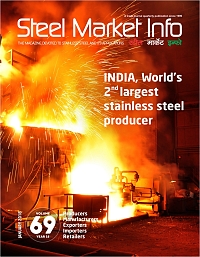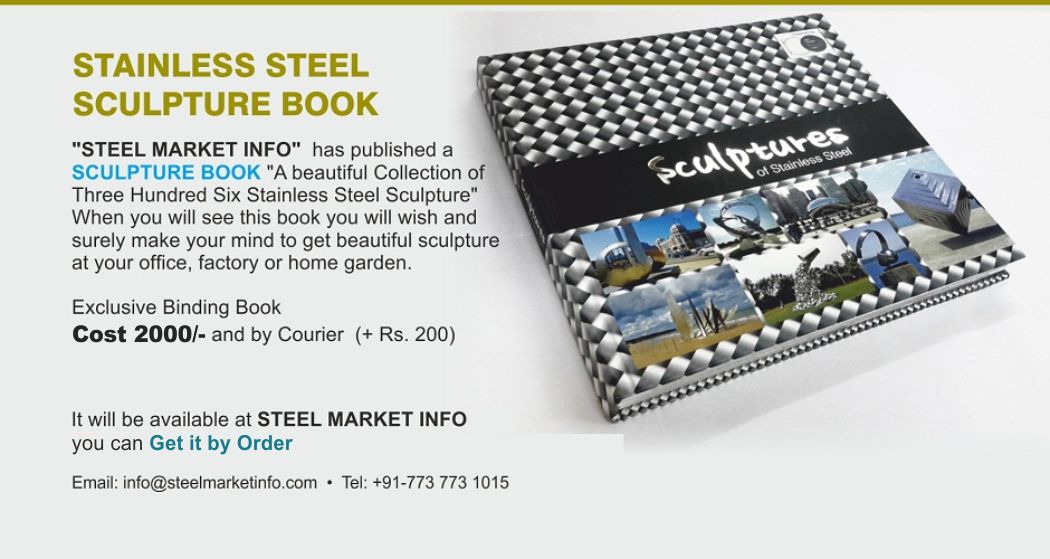
|
Cover StoryIndia is world's 2nd largest
Initial Growth of Stainless Steel Industry in India Though stainless steels were initially developed in the first quarter of last century, it was just four decades ago when stainless steel first production started in India and was primarily getting used for pots and pans in kitchen with some exception in engineering use. Till 1978, the production of stainless steel in the country was nil and most of the requirements were met through imports only. It was in 1978, ASP & VISL ( Both a part of SAIL now) started producing plates, rounds and billets taking country domestic consumption to 18000 MT per annum. Production picked up only in 1980s when new producers Bihar Alloy Steel and Jindal Strips (JSL now), G.M. Mittal (Rathi Alloys) entered into the business and started flat bar (called patta now) production suitable for re-rolling to sheets used for utensil industry. Availability of indigenously produced flats accentuated the emergence of new facilities for re rolling near Jagadhari, Jodhpur, Delhi and Ahmedabad. A small growth in domestic production started to get noticed which reach to 50,000 MT per Annum. Still the lack of indigenous cold rolling facilities to produce wider coils restricted the use of stainless steel to kitchen utensils only. It was only in 1985 when SAIL (salem) plant started the first cold rolling unit in the country. The production touched 102,000 MT per annum and meanwhile growing demand for the use of stainless steel for utensils allowed to bloom and spread the 'patta' industry in other regions of the country specially in the state of Gujarat and Maharastra. During 1990 nickel prices increased sharply and it touched to 18000 US$ /MT and on the top of that there was a 55% import duty levied by government of India at that time. India being fully dependent on import on nickel and nickel still being an important element, since most of the production was in 304 grade stainless steel. it was almost impossible to continue the growth of stainless steel in the country. Meanwhile introduction of new technologies for processing stainless steels was coming up for faster and quality production of stainless steel all over the world. Upto mid 60's, the stainless steels were manufactured mostly by Electric Arc Furnace - Ingot Casting -Slabbing and hot rolled to coil/sheets in hot strip/plate-sheet mills. The advent of technologies of AODNOD in 1990s allowed the Indian Producers to replace nickel with Manganese and Nitrogen still maintaining the austenitic structure of stainless steel. Nickel price instability forced Indian producers to research and the birth of a variety of 200 series grades (low in nickel and high in Mn and Nitrogen austenitic stainless steel) took place. Till now, many new producers Mukund, Panchmahal, Facor, Viraj forayed into production of stainless steel long products and started their productions taking over total production of India to 250000 MT. Although stainless steel industry was growing at a very steady rate in the country but till 1989-1990s more than 90 % of use was still in kitchen and related applications. Meanwhile, western and other developing countries started using stainless steel in more and more applications such as rail coaches, tankers for carrying liquids, pipelines for carrying oil, gas, liquids including potable water, various products for architecture, building and construction. Initial Growth of Stainless Steel Industry in India In 1988 representative of producers of stainless steel from India were visiting to London on invitation from Ni and Cr producers. At that point in time only four Stainless Steel Development Associations were exiting (Japan, Germany, Italy & South Africa). There has been a marked difference in the stainless steel market development in these countries compared to others that made us think about India. We could feel that a neutral body with the sole purpose of developing a market has larger influence when compared with different organizations working in parallel to increase their market. The excitement paved the way and work started immediately after our return from the UK. Formally ISSDA was born in Nov 1989 as non-profit Organization after long debates and taking in to confidence key manufacturers (seven producers) of stainless steel. This was the time when India was producing meager quantities of stainless steel and nickel prices were hitting the roof. The challenge was tough and not much was in sight as to what could be the way to work on our mission. But we were determined to bring about a revolution in the Indian market. This was the time when the development of Cr-Mn 200 series stainless steel just started. The main objective of ISSDA was Today we see use of stainless not only in kitchen but in Indian Railways & Metro Rail Coaches, Wagons, tankers. various products for building & construction & process Industry but also in sectors such as Nuclear, Power, Oil & gas where high quality & grades that are indigenously produced, supplied and are being used. Present Production and The world Crude Stainless Steel production in 2013 is estimated over 38 million tons. The world production has grown at a CAGR of 5 % pa over the last 10 years. Asia has strongly emerged as both the world's largest stainless steel producer and user. Although China dominates the production of stainless steel accounting for more than 50% share of world production. India has been a part of this impressive growth with its production reaching 3 million tons in 2013 making it the 3th largest producer and 2nd largest user of stainless steel in the world. The average growth in India has recorded a CAGR of over 10 % over the last 10 years which is more than a double the world average growth during the period. The main Stainless Steel consuming segments can be classified into 6 to 7 broad categories e.g. Metal products, Process and Engineering industries products; Electro mechanical and electronics; Construction, Transportation and others including medical, blades, coins etc. Out of these Metal products, Process Industries and Engineering goods etc are relatively mature application areas whereas areas like construction and automobile are still evolving in the country and have great future potential for growth. Fig. 3 & Fig. 4 present the consumption patter of stainless steel flat and long products by major market sectors respectively. Here it is worth noting that all sectors have increased their share of consumption at the expense of Metal good segment. Traditionally metal good sector including utensils and cookware has been the largest consuming sector of Stainless Steel in the country now accounting for 52% share of the overall consumption of stainless steel down from 75% in 2004. The single biggest contributor to this segment is the utensils/cookware which has grown at only 4.5% annually due to its already high level of penetration and its direct linkage with population growth. Almost 83% of the consumption of stainless steel in metal good sector is accounted by very low Nickel austenitic stainless steel flats popularly known as 'Patta'. The automotive, railway and transport (ART) sector is now emerging as the fastest consumption segment of Stainless steel in the country. This segment has grown the fastest 32.39% over the last 8 years propelled by large requirements from railway wagon, coaches and automotive exhausts. The Indian automobile industry has grown rapidly in the past with India emerging as a major hub for small cars. All major international players are having their presence in India. Auto exhausts has been the major consumption segment for Stainless steel in this sector followed by disk brakes, cylinder head gaskets and exhaust manifold gaskets. Almost entire requirement for stainless steel to be used for auto sector in the country is of 409 L grade. Railways too have emerged as the largest consuming segment of Stainless Steel in the ART Railways are procuring about 2500 coaches and 12000 wagons annually of stainless steel where a mix of 300 series and 400 series stainless steel grades are being used. This Procurement cycle is expected to continue for next several years as the railways have plans to switch over to stainless steel for all its coaches for all luxury trains. Besides this there has been rapid growth in demand for metro coaches in the country and is expected to grow manifolds. One of the new emerging segments for stainless steel consumption is the architecture, building and construction (ABC) sector. The ABC sector is mostly driven by growth in Indian real estate sector consisting of residential real estate, commercial real estate, retail space., entertainment space, hospitality projects and SEZs. All high quality construction projects like retail outlets, shopping malls, multiplexes. Airports, Rail Metros, IT parks, Commercial Complexes, Hotels, Fast food restaurants, High Quality Residential accommodations, Hi tech town ships and showrooms etc in the country today are finding big outlet for stainless steel in different ways and product forms such as Railings, Roofings, Barriers, signages, claddings and building facades. In all these construction. stainless steel is penetrating in place of conventional materials like steel, glass, plastics, aluminium composites etc. Process industry historically has been consistent consumer of Stainless steel. Stainless steel is used in wide ranging process industries including Refineries, Petrochemical,Chemicals, Dairy, Power, Textile, Sugar, Food processing, Distilleries, Fertilizer, Cement, Drugs, Paper and pulp and others. This sector mainly consumes 300 series grade of stainless steel. The process and engineering industry requirement has increased over the years and is tied with the health of the general economy and investments in projects. Major share of the consumption within process industry is accounted by Heat exchangers, pressure vessels, reactors and columns etc. From being a very insignificant player in the world market about a decade ago to become world third largest producer the Indian market has demonstrated a steady growth in the past years. Maintaining this positive trend will require a lot of marketing and development activities. The efforts should be made to ensure that the use of Stainless Steel in infrastructure should be made mandatory by planning commission and specified in the standards. There is a need to create awareness among designers, specification writers about the benefits of stainless steel to reduce the level of ignorance about the material and thus, create new application areas using the life cycle cost benefits of specifying material. Some new initiatives taken by our government on building smart cities, focus on improving sanitation & waste management facilities, building new infrastructure are likely to give a strong push to the demand coming from multiple application areas in these projects. For example Indian Railways station redevelopment project is one of the largest transit-oriented development programme of its kind in the world which is likely to generate good demand for stainless steels. National steel policy released by Ministry of Steel has also emphasized on the concept of life cycle costing while selecting material in projects for long term benefits and stainless steel is likely to be a big winner in some of the key infrastructure projects. We have a strong and stable government at the centre and sound economic policy. The new GST regime, a major tax reform unfolded from 1st July 2017. We have a young population with 65% below age of 35. All this and huge government spending for Infra sector is very positive for Stainless Steel demand growth going forward. |
January 2018



Useful Link

